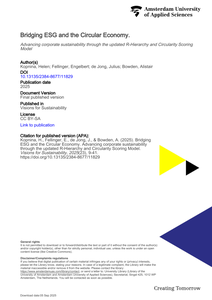This paper explores the relationship between Circular Economy (CE) and Environmental, Social, and Governance (ESG) frameworks—a connection that remains ambiguous in both academic literature and practical application. This lack of clarity hinders corporate accountability and progress toward sustainability goals. To address this, we examine how CE and ESG intersect by integrating relevant theories and practical approaches. We identify key strategic overlaps across diverse CE and ESG indicators and frameworks, demonstrating how each can inform and strengthen the other. We begin by outlining foundational theories and current practices in both CE and ESG, then explore how their integration can enhance organisational alignment and accountability, particularly in the environmental dimension of ESG. To support this synergy, we propose an updated 10-R framework for qualitative reporting, incorporating new dimensions such as Regeneration (e.g., Rewilding and Restoration) to reflect biodiversity considerations. Additionally, we introduce the Circularity Scoring Model (CSM) to assess organisational CE performance concerning ESG objectives quantitatively. Our findings suggest that embedding CE principles into accounting and investment practices can highlight opportunities for improvement, such as transitioning to renewable energy, sourcing alternative materials, extending product lifespans, enhancing repairability, minimising waste, and increasing use of recycled or regenerative resources.
DOCUMENT

Purpose: The purpose of this study is to find determinants about risk resilience and develop a new risk resilience approach for (agricultural) enterprises. This approach creates the ability to respond resiliently to major environmental challenges and changes in the short term and adjust the management of the organization, and to learn and transform to adapt to the new environment in the long term while creating multiple value creation. Design/methodology: The authors present a new risk resilience approach for multiple value creation of (agricultural) enterprises, which consists of a main process starting with strategy design, followed by an environmental analysis, stakeholder collaboration, implement ESG goals, defining risk expose & response options, and report, learn & evaluate. In each step the organizational perspective, as well as the value chain/area perspective is considered and aligned. The authors have used focus groups and analysed literature from and outside the field of finance and accounting, to design this new approach. Findings: Researchers propose a new risk resilience approach for (agricultural) enterprises, based on a narrative about transforming to multiple value creation, founded determinants of risk resilience, competitive advantage and agricultural resilience. Originality and value: This study contributes by conceptualizing risk resilience for (agricultural) enterprises, by looking through a lens of multiple value creation in a dynamic context and based on insights from different fields, actual ESG knowledge, and determinants for risk resilience, competitive advantage and agricultural resilience.
DOCUMENT

We summarize what we assess as the past year's most important findings within climate change research: limits to adaptation, vulnerability hotspots, new threats coming from the climate–health nexus, climate (im)mobility and security, sustainable practices for land use and finance, losses and damages, inclusive societal climate decisions and ways to overcome structural barriers to accelerate mitigation and limit global warming to below 2°C.
MULTIFILE

Systematic literature review on digital transformation skills
DOCUMENT

The paper deals with the hot issue of entrepreneurship education and describes the rationale behind the gamified and collaborative courses for university students conceived, developed and deployed in the framework of the eSG (stimulating entrepreneurship through Serious Games) project, funded under the EU lifelong learning (LLP) Programme. The project aims to help students becoming familiar, mainly through practice, with basic concepts of entrepreneurship and company management and to stimulate the emergence of their entrepreneurial attitudes. In the framework of the project specific courses mainly grounded on the concepts of gamification and collaboration were designed and carried out in three different partner countries: Italy, Spain and the Netherlands. The main objectives of the courses are presented in this paper and a theoretical model supporting the choice of Serious Games is shown which keeps into account usability, pedagogy and the entrepreneurship skills expressed by state of the art models.
LINK
The paper draws a comprehensive overview of relevant.•The paper critically analyzes the state of the art, indicating directions for future research. The paper discusses adoption of Serious Games (SGs) for supporting development of an entrepreneurial mindset in university students of technical and scientific universities. The paper relies on the authors experience in the eSG project, which aims at introducing students, mainly through practice, to basic concepts of entrepreneurship and company management. In the framework of the project, courses have been designed and carried out in three different countries: Italy, Spain and the Netherlands.The paper discusses the main requirements for the courses and presents a table template, based on state of the art models for entrepreneurship education, that we have used for the scouting of the most suited SGs and defining the most appropriate mix for their use in the courses, keeping into account targeted competences and skills, usability and pedagogical effectiveness.Using the template, the paper draws a comprehensive overview of relevant SGs available on the market and identifies, through an expert analysis, key benefits and issues concerning their adoption in teaching entrepreneurship for the target students. Finally, the paper critically analyzes the state of the art, indicating directions for future research that should lead to development of more effective SGs for entrepreneurship education.
DOCUMENT
Understanding the decision-making process of a boardroom is one of the most fascinating parts of organizational research. We are all interested in power games, team dynamics and how the external environment could influence the decision of directors. One of the important buzzwords of today is “good governance” and many boards face a lot of societal pressure to implement best practices of governance. It goes beyond regulatory requirements and boards need to take a different perspective on integrating governance codes and best practices in their organizations. In this study, we focused on the role of individual directors in developing organizational responses to that pressure. More specifically, we looked at how directors’ own cognitive frames of governance influence the way boards choose best practices.
MULTIFILE
